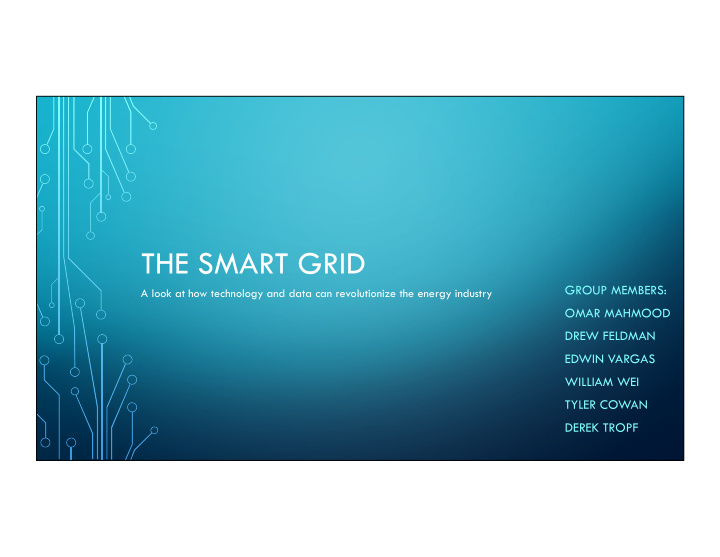



THE SMART GRID GROUP MEMBERS: A look at how technology and data can revolutionize the energy industry OMAR MAHMOOD DREW FELDMAN EDWIN VARGAS WILLIAM WEI TYLER COWAN DEREK TROPF
WHAT IS A SMART GRID? • Computerized and automated electricity grid • Uses sensors to collect data • Allows utilities and consumers to use this data to reduce carbon emissions
WHAT IS A SMART METER? • Measure current, voltage, frequency; store and transmit data • Two-way communication between consumer and utility • Some technical details: • Phasor Measuring Units measure parameters • Measurements time-stamped using GPS time – now called synchrophasors • Synchrophasors can be meaningfully aggregated and compared Source: NERC
WHAT DO WE NEED? • Your investment! • $ 338 billion over 15 years for entire US grid – install smart meters and sensors, upgrade old infrastructure, develop billing and communication systems • Huge benefit – $1.3 trillion to $2 trillion • Smaller budget? Don’t panic! • Focus on smart meters and sensors, and for a smaller geographical area Source: EPRI
WHY SHOULD WE DO THIS? • Reduction in energy use and carbon emissions* • Direct reduction: 12 % • Indirect reduction: 6 % * “Assumes 100% penetration of smart grid technologies” Source: PNNL
HOW WILL SMART METERS AND SENSORS CHANGE EVERYTHING? HOW DOES DATA REALLY HELP US?
REDUCE VARIABILITY OF RENEWABLES • Renewables are intermittent • Aggregate power from various geographic areas when needed – more steady/reduced variability • Make use of interruptible rates
ENABLE DISTRIBUTED GENERATION • Utilities currently wary of letting people put electricity into the grid • Sensors, smart meters give live information, control over distributed systems • Utilities more reassured and willing to encourage distributed generation • Better valuing and pricing of distributed systems
DISTRIBUTED GENERATION – MORE RENEWABLES • Renewables have high initial fixed cost but low operating costs • Utilities do not have capital to finance many projects • Distributed generation allows private sector to finance projects • Utility as mediator – (heavily regulated) capitalism!
DISASTER RESILIENCE • Distributed generation spreads risk • Data immediately indicates which areas are affected and how • Greater accuracy • Faster response times • Fewer resources needed
CONSUMER-DRIVEN SUSTAINABILITY • Consumers can be told when electricity is being produced by a high proportion of renewable sources through their smart meters • People can be expected to shift consumption to renewable-heavy time periods
WHAT SHOULD THE FUTURE HOLD?
CYBER-SECURITY • Interconnected grid – concerns over privacy, hacking, attacks • Create security architecture • Create algorithms to detect suspicious activity, protect against intrusions • Create legal framework to handle data usage
A SMARTER GRID • Install more smart meters and sensors so that we can meet the 2030 target • Retrofit grid infrastructure • Incentivize buildings to upgrade • Expand distributed generation • Incentivize private sector involvement • Improve algorithms
URLS FOR REFERENCE • http://www.nerc.com/docs/oc/rapirtf/RAPIR%20final%20101710.pdf • http://energyenvironment.pnnl.gov/news/pdf/ PNNL-19112_Revision_1_Final.pdf • http://www.epri.com/abstracts/Pages/ProductAbstract.aspx? ProductId=000000000001022519
Recommend
More recommend